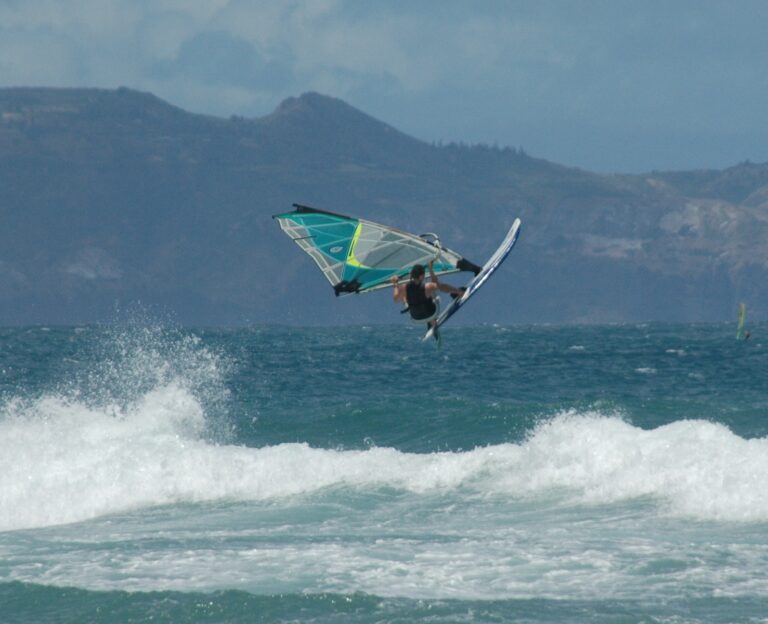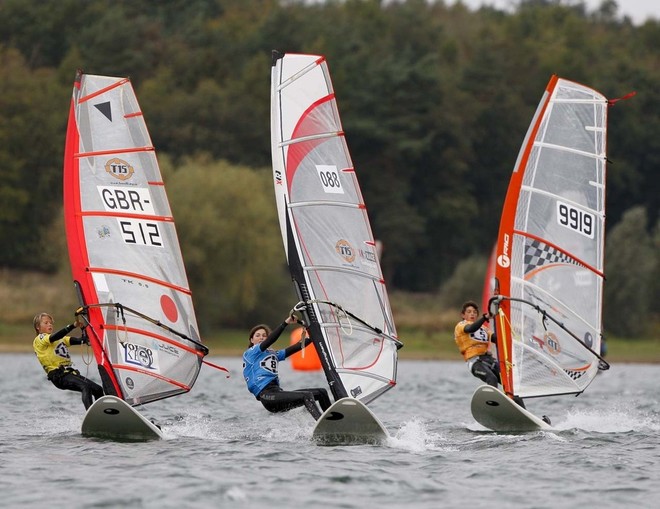The Armed forces are deployed in Theatres of Operation in several parts of the world. However, what isn’t commonly known is that the Forces place great importance on what is available to their personnel when they have recreational time between deployments. The activities available can be many and varied, but windsurfing is given a high priority.
The RYA’s Laurence West caught up with Major Jed Cunningham, British Army Officer, who started windsurfing as a junior soldier, to hear his windsurfing story…

LW: When did you first start windsurfing?
JD: In 1992 I went on an adventure training exercise in Lancashire and went with one of the groups to Pine Lake for water sports. Windsurfing was the first that I tried on the menu and I got hooked. I decided not to do anything else that week and came away with an RYA Level 2 certificate.
LW: What attracted you to try windsurfing?
JD: My boss in 1992 was a windsurfer who wouldn’t shut up about it and as I am very competitive I made it my mission to get as good as I could and overtake him.
LW: Can you ever sail while on active duty?
JD: There are operational locations that are safe enough to windsurf such as Cyprus, The Falklands and the Ascension Islands, to name a few but I tend to go on operations where the sun shines, the sand is golden and there is no sea; however, I was located on an airfield in the desert once and fancied a sail so I fashioned a windsurfer from a camouflage sheet, a couple of poles and a mechanic’s crawler board and off I went across the runway. It sailed just like a wave board!

LW: How do your colleagues view your windsurfing activities, do they pull your leg?
JD: I would have to say that it is normally respect with a touch of envy that I get from my colleagues. Most of those in the Army are sporty people that do a range of diverse sports and as windsurfing is a core ingredient of Army adventure training most are familiar with it. As for leg pulling – I leave that to the physio.
LW: What type of windsurfing do you prefer?
JD: I own 7 sails below 5.7 and a 93, 79 and 68 board – so what do you think? Wave sailing would be my preference although as I am a Formula sailor too, I do like to race.

LW: Does the Army help you with your windsurfing and if so, how?
JD: The Army has helped me throughout my windsurfing career with training. After gaining my first ticket at Pine Lake I have been taught at Army run, RYA recognised centres gaining RYA Senior Instructor status, becoming an RYA club racing coach and have been on a plethora of clinics. I particularly remember our own Army Coach, Jon Metcalfe, coaching me through my first full forward loop at Brook on the Isle of Wight a few years ago. Awesome!

LW: What does windsurfing offer you that other sports don’t?
JD: Windsurfing is an extreme sport that I can do on my doorstep and as it is such an energetic sport I get to stay mega fit just by having fun. The only other sport that I can compare it to is snowboarding but I don’t live in the Alps and snow-boarding hurts more when you crash.
LW: Is there any competition within the Army and other services?
JD: We live to compete. The number of events we have compare with the UKWA as do the numbers attending. The season starts with an Inter-Service wave event at Rhosneigr and then onto a multi-discipline event in the Force Opens at Hayling Island with course, slalom, master blasters and a long distance race. This year we went around the Nab Tower in 19 knots with 9m sails; some 16 miles. There were nearly 50 sailors at that event.
The Army Championships follow this with course and slalom racing. It is then on to Renessee in Holland for the North West Europe Windsurfing Championships where we get to compete against those stationed on the continent.
It’s then on to the National Windsurfing Festival, British Forces Germany Championships, Weymouth Speed week and finally, in October, the Inter-Service Championships which, incidentally, the Army won last year; fortunately I returned from Afghanistan a week before that event so I was able to compete. Interspersed with these events are Corps regattas that are open to all. Throughout the season we encourage novice sailors and have bespoke events for them at each regatta.

LW: Is the Army able to provide any kit for you to use?
JD: We are so fortunate in the Army as most of our competition equipment (less wave gear) and the training equipment is provided by the Army; either by the Corps yacht clubs or through other Army funding. Cool down taxpayers! None of our equipment is purchased with public money. It is all from non-public sources. This allows the lowest ranks, who could not otherwise afford to compete, get the opportunity for glory and have a lot of fun.
LW: Do they have any other resources you can take advantage?
JD: The most significant resource we have are the RYA training centres that we have around the world. They are the engine room of our sport and under the watchful eye of Jon Metcalfe, the Army Sailing Association Windsurfing Manager, they continue to improve and produce new disciples of the sport for the likes of me to turn into true followers.

LW: Is there any one person who inspires you and your windsurfing?
JD: I am most inspired by my son, Chris Cunningham, who I taught to windsurf at 10. By 15 he was back looping and he lived the dream for a few years bumming around the world on a board. He is still way better than I.
LW: Without giving any military secrets away, have you sailed in any dream locations?
JD: The Army has been on windsurfing expeditions to Hawaii, Lake Garda, Dahab and many more but the one I most enjoyed was the World Freestyle Championships in Bol, Croatia. It wasn’t just a great event but an adventure too. At the time I was the Army team captain and was asked to put a team in the event with just three weeks’ notice. It would take longer than that to get political clearance so I planned it on the fly. I spoke to a few mates in the RAF and got our gear to Banja Luka in Bosnia on a transport plane. I then borrowed a minibus from the Security Base there, took the seats out and loaded the gear. We drove through to Croatia, lucked out on a hotel in Bol for the four of us and had a great week sailing. What an adventure!
LW: Have you tried any other sports with the Army?
JD: I didn’t join the Army until I was 24 and up to that point the only sport I’d tried was darts in my local. Since then I have got into X-country running, orienteering, parachuting, skiing, snowboarding and squash. I have also tried dingy sailing and kite surfing but they never really flicked my switch. The one great thing about the Army is that you can actually try anything and get support to do it. I suppose if I hadn’t joined the Army I would be writing this article for Dartboards Online.
LW: Are you able to help others in the forces who would like to learn?
JD: I have pretty much hung up my Start Windsurfing Instructor shoes I’ll leave that to the RYA Centres that are doing such a great job. Where I come in is the day after their Start course and develop them through to independent sailors and racers. As the Royal Artillery Rear Commodore Windsurfing I have control of about 30 boards and rigs that the Royal Artillery provide for the soldiers to develop and race. As the Army Sailing Association’s windsurfing race secretary I am involved in the organisation of events and act as the race officer for the Novice class. Please don’t give me any more hats. I do have a day job.
LW: Have you any plans for when you eventually leave the service?
JD: I’m going to take up golf – until it gets to 10 knots and then you’ll see me on the water. I may even get time to do the UKWA circuit again. Living the dream!
LW: Do you have any advice for others in the service who might be considering watersports?
JD: I would just say give it a go, if you don’t like it move on to something else. If you do like it, it could change your life. Use the link to find out about courses and opportunities. http://www.sailarmy.co.uk/windsurfing/index.html
LW: What would be your perfect day on the water?
JD: Chris and I on 4.5s, sharing a wave.





